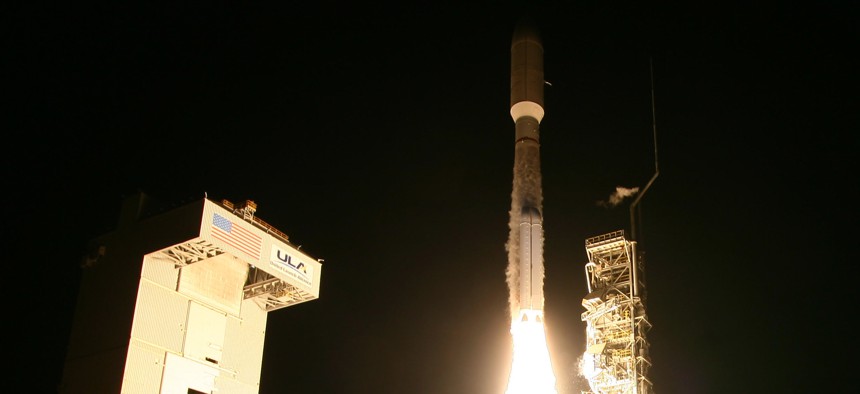
A United Launch Alliance Atlas 5 rocket carrying the classified NROL-42 satellite lifts off from Vandenberg Air Force Base in California in September 2017. AP Photo/Matt Hartman
Here’s The Pentagon’s Initial Plan For Creating a Space Force
Parts of the Air Force, Navy and Army would move into a sixth branch, but the NRO will likely remain independent.
The U.S. Space Force will include uniformed service members drawn from the Air Force, Navy and Army — but it is not expected to include the National Reconnaissance Office mission, according an internal draft of the Pentagon’s plan to create a sixth branch of the military.
Defense One reviewed a copy of the 13-page document, which will be further developed in coming months before the Pentagon sends it to Congress in February along with its 2020 budget request. This early draft provides a glimpse into a 21st-century approach to creating a new service branch, an endeavor not undertaken since 1947. Among other things, it reveals divergent views among senior Pentagon officials about how to structure it.
For example, the document says the Space Force will not “include the transfer of [the] strategic intelligence, surveillance, reconnaissance mission of the National Reconnaissance Office (NRO). But the Space Force and the National Reconnaissance Office will be integrated through ...NOTE FURTHER INPUT HERE LATER REGARDING DOD/IC integration.” Note that in a Sept. 14 memo to Secretary Patrick Shanahan, Air Force Secretary Heather Wilson Deputy Defense recommended including NRO in the Space Force.
The draft document calls for Space Force to absorb parts of Air Force Space Command, the Navy’s Space and Naval Warfare Systems Command, the Naval Satellite Operations Center, and the Army’s 1st Space Brigade.
Related: Air Force Pushes Back on Pentagon’s First Blueprints for Trump’s Space Force
Related: What Trump’s Space Force Announcement Means
Related: USAF’s Space Force Cost-Estimate Is Likely Too High: Analyst
Related: Mattis Asks Trump to OK US Space Command, Pick Leaders
The document says the installations and facilities where those units are based will remain part of their respective services until the Space Force “reaches an appropriate operating capacity.” There are six Air Force Space Command bases: three in Colorado, two in California and one in Florida. The Army’s 1st Space Brigade is based in Colorado. The Navy’s San Diego-based SPAWAR has facilities around the world. The Naval Satellite Operations Center is at Naval Air Station Point Mugu, California.
The existing military services would still “retain organic space capabilities uniquely designated to support that Service’s or organization’s mission,” the document says. “Additionally, each Service may retain a cadre of space experts that serve as liaisons to advocate for and potentially operate space-related capabilities unique to its respective domain.”
Among the Space Force’s missions: space situational advantage; battle management command and control of space forces; space lift and range operations; space support to nuclear command and control; missile warning; satellite communications and position, navigation and timing.
“The Space Force will only be responsible for those missions directly associated with joint space operations,” the document says.
Missions that “that are tangentially associated with space” — including nuclear intercontinental ballistic missiles, cyber operations and “the overall missile defense missions” — will not be part of the Space Force, at least initially.
“Inclusion of these missions into the Space Force may be reevaluated in the future, as necessary,” the document states.
Pentagon officials have stressed their desire not to add layers of bureaucracy. Wilson, in September, said an additional 13,000 people would be needed. The draft Space Force proposal mentions a “lean headquarters model,” but does not list any numbers.
However, the plan says that the new branch would have a secretary and chief of staff, who would be a member of the Joint Chiefs. It also talks of creating a Space National Guard and Space Force Reserve.
The plan talks of creating a “pilot program” to enable the Space Force “to acquire talent from the civilian market in a rapid manner for a defined period after which the individual would return to civilian life.”
The draft does not including funding estimates, but has placeholders for a budget proposal and a “Defense Space Strategy.” Wilson, in her proposal, said it would likely cost taxpayers an additional $13 billion over five years to create the Space Force. Defense budget analyst Todd Harrison, of the Center for Strategic and International Studies, called her take “the highest estimate I think you could possibly come up with.”
Earlier this month, Shanahan said Pentagon officials would be figuring out the Space Force budget in October and November.




